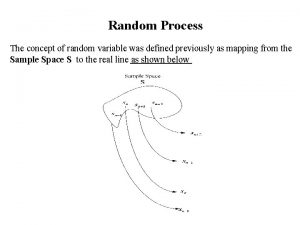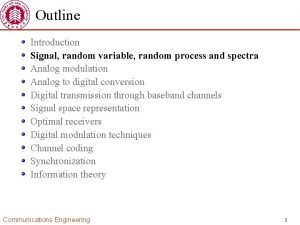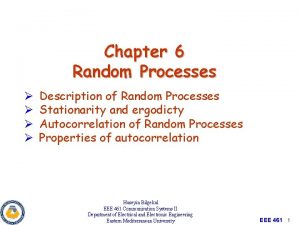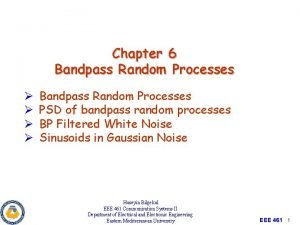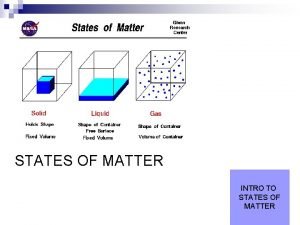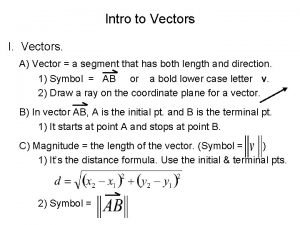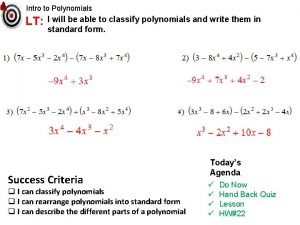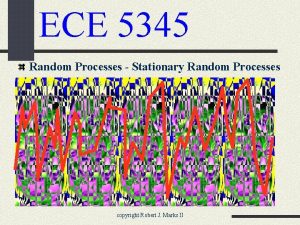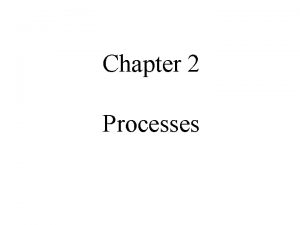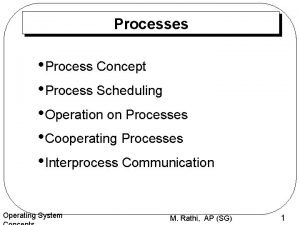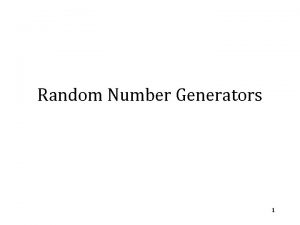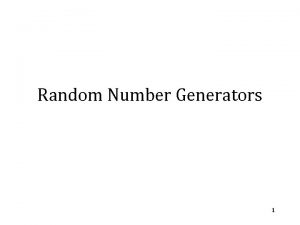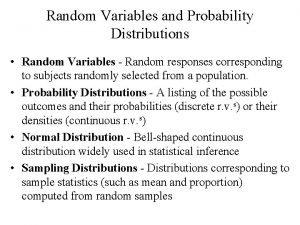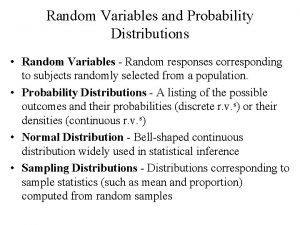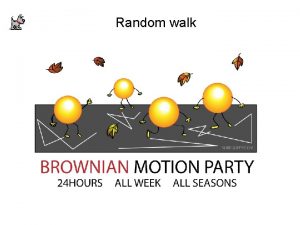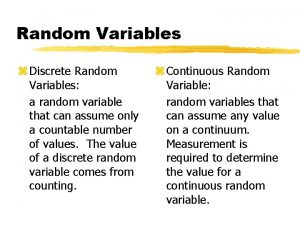10 Intro to Random Processes A random process

















































- Slides: 49

10 Intro. to Random Processes A random process is a family of random variables – usually an infinite family; e. g. , { Xn , n=1, 2, 3, . . . }, { Xn , n=0, 1, 2, . . . }, { Xn , n=. . . , -3, -2, -1, 0, 1, 2, 3, . . . } or { Xt , t ≥ 0 }, { Xt , 0 ≤ t ≤ T }, { Xt , -∞ < t < ∞ }.

Recalling that a random variable is a function of the sample space Ω, note that Xn is really Xn(ω) and Xt is really Xt(ω). So, each time we change ω, the sequence of numbers Xn(ω) or the waveform Xt(ω) changes. . . A particular sequence or waveform is called a realization, sample path, or sample function.

Xn(ω) for different ω

Zn(ω) for different ω

5 sin(2πfn) + Zn(ω) for different ω

Yn(ω) for different ω

Xt(ω) = cos(2πft+Θ(ω)) for different ω

Nt(ω) for different ω

Brownian Motion = Wiener Process

10. 2 Characterization of Random Process Mean function Correlation function

Properties of Correlation Fcns symmetry: RX(t 1, t 2)=RX(t 1, t 2)

Properties of Correlation Fcns symmetry: RX(t 1, t 2)=RX(t 1, t 2) since

Properties of Correlation Fcns symmetry: RX(t 1, t 2)=RX(t 1, t 2) since RX(t, t) ≥ 0

Properties of Correlation Fcns symmetry: RX(t 1, t 2)=RX(t 1, t 2) since RX(t, t) ≥ 0 since

Properties of Correlation Fcns symmetry: RX(t 1, t 2)=RX(t 1, t 2) since RX(t, t) ≥ 0 since Bound:

Properties of Correlation Fcns symmetry: RX(t 1, t 2)=RX(t 1, t 2) since RX(t, t) ≥ 0 since Bound: follows by Cauchy-Schwarz inequality:

Second-Order Process A process is second order if

Second-Order Process A process is second order if Such a process has finite mean by the Cauchy-Schwarz inequality:


How It Works You can interchange expectation and integration. If then

How It Works You can interchange expectation and integration. If then

Example 10. 12 If then

Similarly, and then








SX(f) must be real and even:

SX(f) must be real and even: integral of odd function between symmetic limits is zero.

SX(f) must be real and even:

SX(f) must be real and even: This is an even function of f.

10. 4 WSS Processes through LTI Systems

10. 4 WSS Processes through LTI Systems

10. 4 WSS Processes through LTI Systems

Recall What if Xt is WSS?

Recall What if Xt is WSS? Then which depends only on the time difference!

Since






10. 5 Power Spectral Densities for WSS Processes

10. 5 Power Spectral Densities for WSS Processes


 Concurrent processes are processes that
Concurrent processes are processes that Random forest intro
Random forest intro Ergodicty
Ergodicty Random assignment vs random sampling
Random assignment vs random sampling Random assignment vs random selection
Random assignment vs random selection What processes are crucial to the ipde process
What processes are crucial to the ipde process Random process
Random process Random process
Random process Random process
Random process Bandpass random process
Bandpass random process Theme paragraph example
Theme paragraph example Introduction sur les contemplations
Introduction sur les contemplations Types of hooks for informative essays
Types of hooks for informative essays Hook examples
Hook examples How to write a comparative essay introduction
How to write a comparative essay introduction Body conclusion introduction
Body conclusion introduction Intro qr codes
Intro qr codes States of matter
States of matter Find similar images
Find similar images Saturnus yttemperatur
Saturnus yttemperatur Intro body conclusion example
Intro body conclusion example Introduction to reverse engineering
Introduction to reverse engineering Essay on relationship
Essay on relationship Research paper parts
Research paper parts Organic vs inorganic compounds
Organic vs inorganic compounds Intro to offensive security
Intro to offensive security Mitt i naturen intro
Mitt i naturen intro Materialgruppenmanagement
Materialgruppenmanagement Lord of the flies intro
Lord of the flies intro Leq essay format
Leq essay format Description d'un paysage exemple
Description d'un paysage exemple Intro paragraph format
Intro paragraph format Andrew ng intro machine learning
Andrew ng intro machine learning Intro to verilog
Intro to verilog Severance intro
Severance intro Introduction to ifs
Introduction to ifs Intro to hadoop
Intro to hadoop Whats an introduction paragraph
Whats an introduction paragraph Intro
Intro Introduction of company background
Introduction of company background Intro body conclusion
Intro body conclusion Intro to vlsi
Intro to vlsi Intro to vectors
Intro to vectors Orphan graphic design
Orphan graphic design Define stagecraft
Define stagecraft Windows reversing intro
Windows reversing intro Adding and subtracting polynomials
Adding and subtracting polynomials Intro to mis
Intro to mis Intro dns
Intro dns Chapter 10 marketing answer key
Chapter 10 marketing answer key






